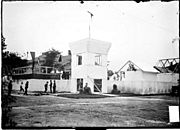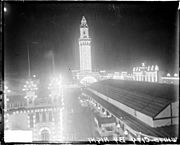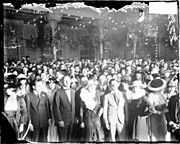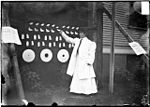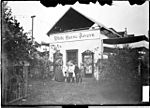White City (Chicago) facts for kids
White City was a famous amusement park in Chicago, Illinois. It was located on the city's South Side, in the Greater Grand Crossing and Woodlawn areas. The park opened on May 26, 1905, and was one of the biggest of its kind in the United States at the time.
White City helped make Chicago a city known for its many amusement parks. It even introduced the world to the Goodyear Blimp, which was first put together there. The park was a popular spot for fun and entertainment for many years, lasting until the 1950s.
What Was White City Like?
White City was a large park, covering about 14 acres. It had beautiful gardens and paths for walking. The park got its name because many of its buildings were covered in white lights. These lights made the park glow at night, looking like a "White City."
One of the main buildings had a huge ballroom. This dance floor was big enough for 1,000 dancers! There was also a tall tower that could be seen from about 15 miles away. A large restaurant called the College Inn could serve 2,500 people at once.
The park was similar to the famous World's Columbian Exposition of 1893, which was also called "White City" because its buildings were painted white. White City Amusement Park was so impressive that it was compared to Coney Island in New York. People didn't pay one price to get in. Instead, they bought separate tickets for each ride or attraction they wanted to try.
Early Days of Fun
White City was planned to be like Dreamland, another popular park in Coney Island. Building the park was a big job. Sometimes, there were accidents during construction. After the park opened, there were a few times when rides had problems, causing injuries.
Even with these challenges, White City quickly became very popular. Many people used public transportation, like the 'L' Train, to get to the park. The number of train riders increased a lot after White City opened.
The park was run by different people over the years. Early on, two brothers, Morris and Joseph Beifeld, were involved. Later, Aaron Jones, a Chicago businessman, was also a key owner. Paul D. Howse, a journalist, was one of the park's founders and its first general manager.
In its first years, admission to White City cost ten cents. The park was open no matter the weather. On sunny days, people enjoyed outdoor sports and rides. If it rained, they could watch vaudeville shows, see the "Chicago Fire" exhibit, or visit the "Baby Incubators" and "Wild Animals show."
Some of the exciting attractions at the park included:
- Big Otto's Trained Wild Animal Show
- Hale's Tours of the World (a simulated travel experience)
- Flying Airships
- A Ferris wheel and a miniature railroad
- The first Shoot-the-Chutes ride in Chicago
- A roller coaster
- The Garden Follies Dancers
The park also had regular outdoor concerts and a roller rink. Famous performers like Annette Kellerman and Sophie Tucker often put on shows there. Daredevil pilots like Horace Wild also performed amazing aerial stunts.
One popular exhibit was "Midget City." This display featured 50 men and women with dwarfism, who created a miniature city with tiny buildings and even small horses. Another popular exhibit was the "Chicago Fire." This show recreated the famous burning of Chicago with miniature buildings, fire, and smoke effects.
From 1906, the Chicago Tribune newspaper used White City to host an annual event to help Chicago's hospitals. The money raised went to help babies who needed special care. The "Baby Incubators" exhibit was a big part of this effort. It showed tiny infants in incubators, which were not common in all hospitals at the time. This exhibit helped raise money to get more incubators for hospitals in Chicago.
In October 1910, White City hosted a large Christian event. The park's ballroom, which could hold almost 4,000 people, was used for a big gathering with a chorus of hundreds.
Challenges and Changes
In September 1911, a serious fire broke out at White City. It started near the railway and damaged parts of the park, including the scenic railway and half of the Figure 8 roller coaster. Luckily, firefighters were able to control it, and no one was seriously hurt.
During the 1920s, White City continued to host charity events. The Chicago Tribune newspaper sponsored parties for children at the park. Many children who had never been to an amusement park got to visit for free.
White City was also important for aviation history. It was the place where the first Goodyear Blimp, called the "Wingfoot Air Express," was put together. Other airships also serviced the park, bringing passengers from Grant Park. Sadly, one of these airships crashed in 1919, causing deaths and injuries. This accident led to the creation of Chicago Air Park (now Midway International Airport).
The park faced more fires. In July 1925, another fire caused some damage. A more serious fire in June 1927 started in the ballroom and caused a lot of damage. The tall tower, which had survived the 1911 fire, was destroyed in this blaze. Some people believe this 1927 fire marked the beginning of the end for White City.
Later Years and Legacy
White City often faced financial challenges because its success depended on how well the economy was doing. The Great Depression in the 1930s, along with the damage from the fires, had a very negative effect on the park. Attendance dropped, and by 1933, the company running the park couldn't pay its taxes.
The park continued to decline and was eventually closed in 1939. Its facilities were sold off in 1946.
After the park closed, the land was used for a new housing development called Parkway Gardens. This development was built for African-American families. In its early years, White City Amusement Park had policies that discouraged black people from attending. However, as the neighborhood changed, the park's policies became more open.
The roller rink at White City stayed open for a while. In the 1940s, it became a place where people fought for equal rights. Black people protested to be allowed to roller skate indoors. Groups like the Congress of Racial Equality helped lead these efforts. Eventually, the rink was desegregated and changed its name to Park City, closing in 1958.
Today, White City Amusement Park is mostly forgotten. But in its best days, it was known as "the city of a million electric lights." Its amazing tower could be seen for many miles, making it a truly special place in Chicago's history.


